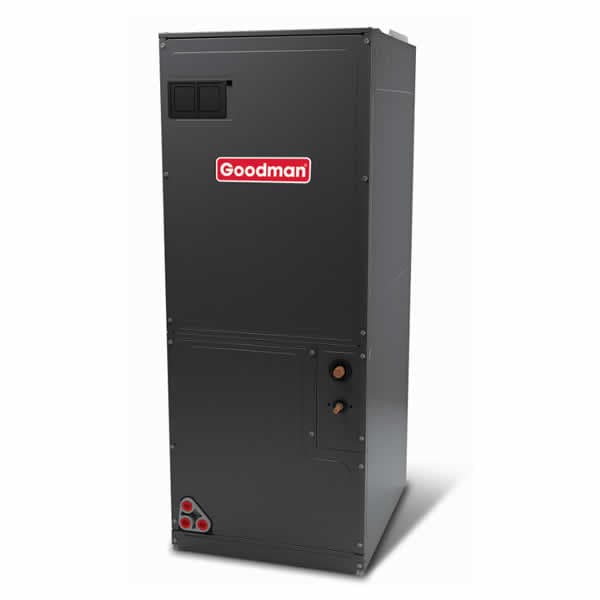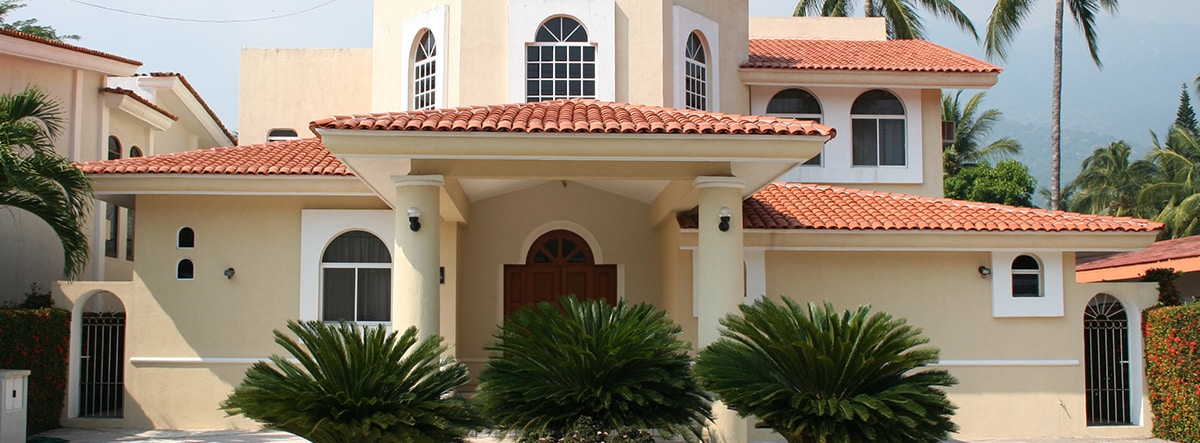
HVAC Air Handlers-101
How an Air Handler Works
If you live in a desert or tropical climate, chances are you have a central air conditioner or heat pump paired with an air handler.
By understanding how your home's HVAC appliances work, you'll not only be a wiser homeowner; you'll also be more comfortable choosing a replacement when the time comes.
What is an Air Handler?
Air handlers are the “lungs” of your home. Paired with heating or cooling equipment, they manage the airflow keeping your home comfortable and clean in any season.
The air handler cabinet houses indoor components of your HVAC system and can fit additional devices that improve air quality and ventilation. This could include adding an electronic air filter, dehumidifier, and UV light for increased air quality and purification.
Surprisingly, an air handler itself doesn’t heat or cool the air at all. Instead, it blows indoor air across an internal heat exchanger or coil to add or remove heat from the air.
Air Handler vs. Furnace
A common question we hear is, "What's the difference between a furnace and an air handler?"
The answer is quite simple. An air handler is just like a furnace on the outside but without the heating components like the burners and heat exchanger. However, they are both large metal cabinets used to condition and circulate the air that flows throughout your home.
If you live somewhere that experiences both blistering summers and freezing winters, you’ve likely got a central air conditioner/furnace setup. In that case, a furnace’s blower acts as the air handler for the air conditioning system.
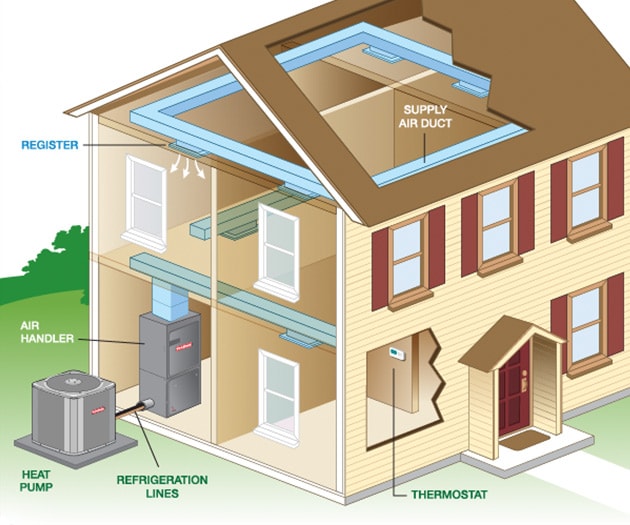
Image: Goodman Manufacturing
How Air Handlers Work
An air handler's main function is to circulate the air in your system, and the components surrounding it alter the functionalities of heating, cooling, and air quality.
Although there are multiple ways and places you can install an air handler, the unit connects to the rest of your home through a series of supply and return ventilation ducts that recirculate the air in each room.
Air handlers can be paired with an air conditioner, heat pump, and sometimes even a mini split system for both heating and cooling functions. Additionally, air handlers can also be equipped with a heating coil to provide supplementary heat.
Just like a furnace, air handlers contain a blower (fan), controls, and an evaporator coil that conditions and recirculates the air in your home. The air handler works with the outdoor unit (a condenser or heat pump) in a typical split-system by using refrigerant lines that connect the two systems.
Components of an Air Handler
Depending on where you live, the parts that make up your system will change. The components listed below are found in the typical heat-pump/air conditioning setups.
- Blower Motor -
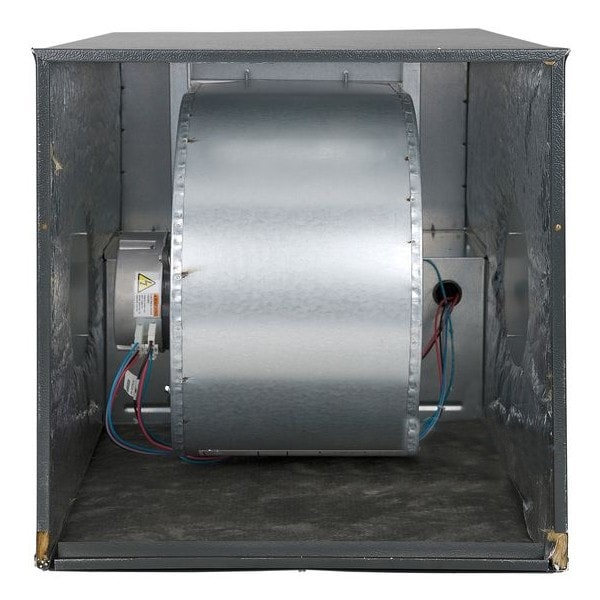 Moves air through the connected ductwork to circulate throughout the home.
Moves air through the connected ductwork to circulate throughout the home.
- Single and multi-speed motors will run at set revolutions per minute (RPM) and are capable of moving consistent amounts of air, measured in cubic feet per minute.
- A variable speed motor, sometimes known as an ECM (Electronically Commutated Motor) monitors changing conditions and adjusts those outputs for maximized efficiency.
- Single and multi-speed motors will run at set revolutions per minute (RPM) and are capable of moving consistent amounts of air, measured in cubic feet per minute.
- Plenum Connectors - Air-collection boxes that connect the supply and return ductwork throughout the home to the air handler.
- The supply ducts deliver conditioned air (heated or cooled) to terminal registers (vents) in each room after passing through the filter and air handler. The return ducts bring unconditioned air back into the system to be filtered and reconditioned.
- The supply ducts deliver conditioned air (heated or cooled) to terminal registers (vents) in each room after passing through the filter and air handler. The return ducts bring unconditioned air back into the system to be filtered and reconditioned.
- Air Filter - Protects the internal components by capturing particulates from the incoming air.
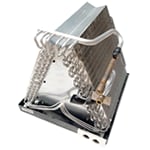
- Evaporator Coil - The essential component of the air conditioning cycle that allows heat energy to be added or removed from the indoor air. The blower forces air from the return ducts through the coils and out through the ductwork.
- Electric Heat Strips (Optional) - Uses electricity to introduce extra warmth. Can be used with either an air conditioning-only system or with a heat pump when temperatures dip too low.
Tying it all Together
Remember that air handlers are like the "lungs" of your home and are the foundation on which other heating, cooling, and air quality equipment is connected to keep your home happy and comfortable.
Now that you know the important role your air handler plays in your overall HVAC system, you'll understand how to choose the best one when it's time to replace.
Central Forced-Air Navigation
HVAC-101 | Gas Furnaces-101 | Heat Pumps-101 | Packaged Units-101 | Air Conditioning-101 | Air Handlers-101
Share My Personal Information\":{\"href\":\"https:\\\/\\\/ferguson.bigidprivacy.cloud\\\/consumer\\\/#\\\/dMf02ovZbN\\\/Form-NHWperWAaFNVIQK\",\"title\":\"Do Not Sell or Share My Personal Information\"}},\"About Us\":{\"Our Stores\":{\"href\":\"https:\\\/\\\/www.powerequipmentdirect.com\\\/our-stores.php\",\"title\":\"Power Equipment Direct's Stores\"},\"Our Story\":{\"href\":\"https:\\\/\\\/www.powerequipmentdirect.com\\\/stories\\\/1982-How-We-Make-Buying-Technical-Products-Simple.html\",\"title\":\"Power Equipment Direct's Story\"},\"Careers\":{\"href\":\"https:\\\/\\\/www.powerequipmentdirect.com\\\/stories\\\/1924-Job-Openings.html\",\"title\":\"Careers @ Power Equipment Direct\"},\"Newsroom\":{\"href\":\"newsreleases.php\",\"title\":\"Power Equipment Direct News Center\"}},\"Contact Us\":{\"phone\":\"800-710-7499\",\"hours\":[\"M-F: 8-5 CST\",\"Sat: Closed\",\"Sun: Closed\"]}}","storeLinkJSON":"{\"AC Wholesalers\":{\"href\":\"https:\\\/\\\/www.acwholesalers.com\",\"title\":\"AC Wholesalers\"},\"Air Compressors Direct\":{\"href\":\"https:\\\/\\\/www.aircompressorsdirect.com\",\"title\":\"Air Compressors Direct\"},\"Chain Saws Direct\":{\"href\":\"https:\\\/\\\/www.chainsawsdirect.com\",\"title\":\"Chain Saws Direct\"},\"Chippers Direct\":{\"href\":\"https:\\\/\\\/www.chippersdirect.com\",\"title\":\"Chippers Direct\"},\"eComfort\":{\"href\":\"https:\\\/\\\/www.ecomfort.com\",\"title\":\"eComfort\"},\"Electric Generators Direct\":{\"href\":\"https:\\\/\\\/www.electricgeneratorsdirect.com\",\"title\":\"Electric Generators Direct\"},\"Leaf Blowers Direct\":{\"href\":\"https:\\\/\\\/www.leafblowersdirect.com\",\"title\":\"Leaf Blowers Direct\"},\"Log Splitters Direct\":{\"href\":\"https:\\\/\\\/www.logsplittersdirect.com\",\"title\":\"Log Splitters Direct\"},\"Mowers Direct\":{\"href\":\"https:\\\/\\\/www.mowersdirect.com\",\"title\":\"Mowers Direct\"},\"Power Equipment Direct\":{\"href\":\"https:\\\/\\\/www.powerequipmentdirect.com\",\"title\":\"Power Equipment Direct\"},\"Pressure Washers Direct\":{\"href\":\"https:\\\/\\\/www.pressurewashersdirect.com\",\"title\":\"Pressure Washers Direct\"},\"Snow Blowers Direct\":{\"href\":\"https:\\\/\\\/www.snowblowersdirect.com\",\"title\":\"Snow Blowers Direct\"},\"String Trimmers Direct\":{\"href\":\"https:\\\/\\\/www.stringtrimmersdirect.com\",\"title\":\"String Trimmers Direct\"},\"Sump Pumps Direct\":{\"href\":\"https:\\\/\\\/www.sumppumpsdirect.com\",\"title\":\"Sump Pumps Direct\"},\"Tillers Direct\":{\"href\":\"https:\\\/\\\/www.tillersdirect.com\",\"title\":\"Tillers Direct\"},\"Water Pumps Direct\":{\"href\":\"https:\\\/\\\/www.waterpumpsdirect.com\",\"title\":\"Water Pumps Direct\"}}","socialLinkJSON":"{\"Facebook\":{\"href\":\"https:\\\/\\\/www.facebook.com\\\/PowerEquipmentDirect\",\"icon\":\"icon-facebook\",\"title\":\"Facebook\"},\"Twitter\":{\"href\":\"http:\\\/\\\/twitter.com\\\/PowerEquipment\",\"icon\":\"icon-twitter\",\"title\":\"Twitter\"},\"Pinterest\":{\"href\":\"http:\\\/\\\/pinterest.com\\\/powerequipment\\\/\",\"icon\":\"icon-pinterest\",\"title\":\"Pinterest\"},\"YouTube\":{\"href\":\"http:\\\/\\\/www.youtube.com\\\/PowerEquipmentDirect\",\"icon\":\"icon-youtube\",\"title\":\"YouTube\"},\"Instagram\":{\"href\":\"https:\\\/\\\/www.instagram.com\\\/powerequipmentdirect\\\/\",\"icon\":\"icon-instagram\",\"title\":\"Instagram\"},\"LinkedIn\":{\"href\":\"https:\\\/\\\/www.linkedin.com\\\/company\\\/power-equipment-direct\\\/about\\\/\",\"icon\":\"icon-linkedin\",\"title\":\"LinkedIn\"}}","miscLinkJSON":"{\"Terms of Use\":{\"href\":\"terms-of-use.php\",\"title\":\"Terms of Use\"},\"Privacy Policy & Security\":{\"href\":\"privacy.php\",\"title\":\"Privacy Policy and Security\"},\"Cookie Policy\":{\"href\":\"privacy.php#cookiePolicy\",\"title\":\"Cookie Policy\"},\"CA Privacy Rights\":{\"href\":\"privacy.php#californiaPrivacyRights\",\"title\":\"CA Privacy Rights\"},\"copyright\":\"© 2024 Power Equipment Direct. All Rights Reserved\"}","checkoutMiscLinkJSON":"{\"Privacy Policy & Security\":{\"href\":\"privacy.php\",\"title\":\"Privacy Policy and Security\"},\"Cookie Policy\":{\"href\":\"privacy.php#cookiePolicy\",\"title\":\"Cookie Policy\"},\"Terms of Use\":{\"href\":\"terms-of-use.php\",\"title\":\"Terms of Use\"},\"copyright\":\"© 2024 Power Equipment Direct. All Rights Reserved\"}","expertJSON":{"imageURL":"https:\/\/www.powerequipmentdirect.com\/images\/experts\/expert-main-13.png","href":"\/product-experts.php?s=13","title":"Contact Dale @ Power Equipment Direct","expertName":"Dale","expertTitle":"Power Equipment Expert"},"bbbJSON":{"imageURL":"https:\/\/www.powerequipmentdirect.com\/images\/badge-bbb.png","imageAlt":"Better Business Bureau","href":"http:\/\/www.bbb.org\/chicago\/business-reviews\/industrial-equipment-and-supplies\/power-equipment-direct-in-bolingbrook-il-57001088","title":"Power Equipment Direct - A+ Rating - Better Business Bureau"},"zipCode":null,"phoneNumber":"","loginToken":"page cache precludes the use of csrf tokens","iterable":"e4b27e68b9c84fbb940829a0a9ee29d7","newNav":false}


